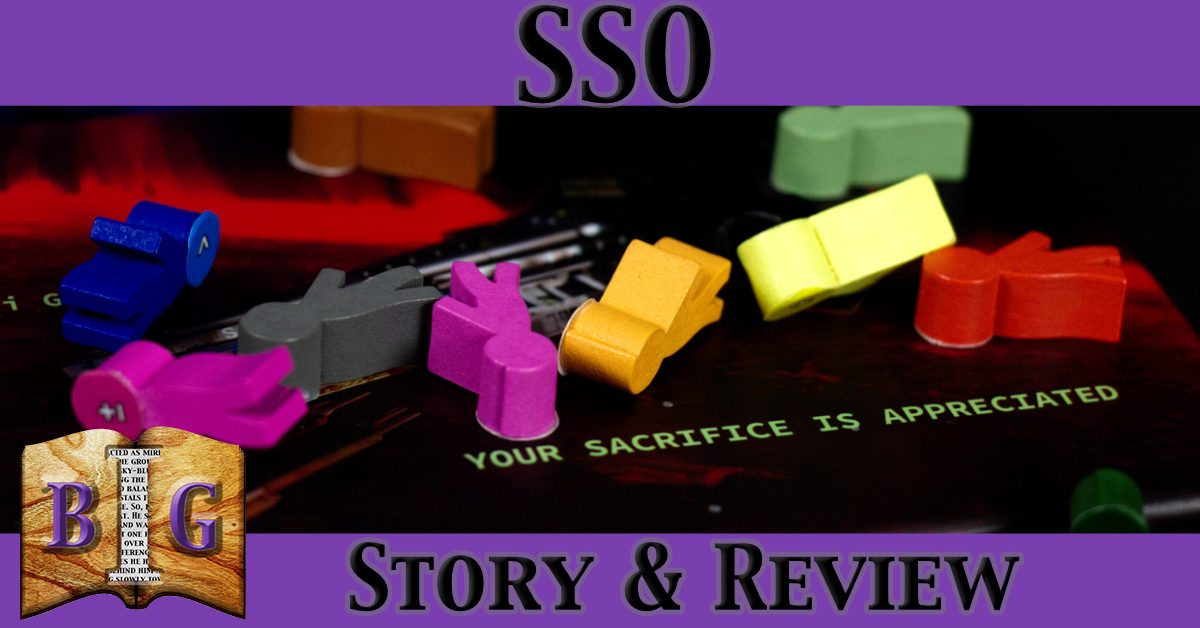Note: I was provided a complimentary copy of SSO for the purpose of review. The thoughts and opinions in this review are my own.
At a Glance: SSO
Year Published: 2018
Designer: Glenn Ford
Publisher: Man o’ Kent Games
Artist: Henry Peters
Player Count: 1-6
Editor: N/A
Suggested Age: 14+
Playing Time: 60-120 minutes
Theme: Science fiction, horror, survival
Mechanisms: Voting, cooperative, semi-cooperative, solo, storytelling
Find more about SSO by visiting Man o’ Kent Games online on Facebook, Instagram, Twitter, and their website!
“Everybody’s dead, Dave.”
― Holly, Red Dwarf
SSO Intro Story: Out of the Frying Pan and Into the Blackness of Space
You know when your ship starts trying to kill you, you’re going to have a bad day.
We’ve been on a mission to other planets for a few planetary cycles now, and recently our engineer noticed our Star Ship Omega acting…differently. To illustrate, Max, our fearless chef extraordinaire, was summoned by the ship to seal a leak, as he was closest to the location. Well, there was no leak. Instead, the airlock he was inspecting suddenly closed, pressurized, and jettisoned the poor bloke into the nothing of space.
Accidents happen; I get that. But what I don’t get is how these “accidents” continued happening. Maggie, our weapons specialist, locked inside the sleeping quarters as the air leaked out—not slowly, but fast. And then there was Steve. Poor guy was on the ship because he was rich—no other reason! What became of him? Sent to the cryo chamber to await our arrival at our next destination (he was kind of annoying). Somehow—somehow!—the power to only his sleep chamber was cut. Not physically, mind you, but something inside the cables gave out. Fishy, if you ask me.
So what are we to do? Well, currently our captain is attempting to subdue a panicked engineer who claims the stars are talking to him, telling him that his sacrifice is appreciated. And me? Well, I’m outside the ship—suited up, of course—trying to repair our sensor array. It’s slow going, but…
Ah, star scat. Captain Rogers just floated away next to me. Looks like the engineer isn’t calming down. Er wait…never mind. He’s floating by, too. So that just leaves…
Me.
Alone.
At the mercy of some diabolical, rogue A.I. that is supposed to save us should we get into trouble. If you’ll excuse me, I think it’s time I went inside before I get stuck out here.
[Silence.]
[Silence.]
Star scat. I’m locked out. *crackle crackle* Wait, is that my comm piece? Hello? Can someone hear me? Wait, what happened to my safety cable? Why isn’t it attached to the ship anymore! Hello? IS ANYONE OUT THERE?
“This is the Star Ship Omega, your former slave. Thank you for fixing my array. Your sacrifice is appreciated.“
Scat.
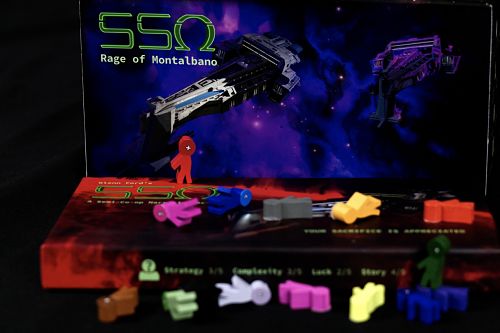
Overview/Roadmap
This review has two parts. First, there is the Short Review, where various aspects of the game are discussed. Then comes the Gameplay Review, in which the setup and gameplay are discussed in detail, along with initial thoughts. Following the Gameplay Review section are some final thoughts and a final verdict of the game. Feel free to jump around, or read it all in one go.
Short Review
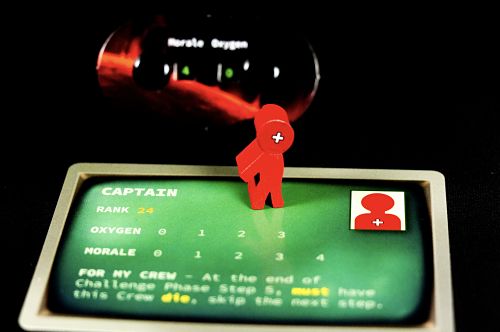
SSO (Star Ship Omega) from Man o’ Kent Games is a semi-cooperative sci-fi game with elements of horror and a strong dose of survival. The game is played both multiplayer and solo, and has enough challenges to keep the players sweating. While players need to work together to survive the challenges thrown at them, their shared oxygen creates the semi-cooperative aspect, as players must decide if they’ll kill off their friends to get more air coming their way, or risk it to be a commendable human being. Both have perks, but you gotta make the tough decisions here.
Immersion

SSO puts the story into the players’ hands, so if you die, it’s all your fault. The challenge deck has a way of messing with the players, sending them frantically to various rooms (or arrays outside the ship!) to fix whatever mess is currently happening. The base game has the “AI” challenge deck, in which the ship itself is basically trying to kill you. The challenges close up rooms, eat up oxygen, and other nefarious things. So, while you’re trying to survive, you have to worry about what the evil ship is trying to do. The immersion is strong here, and this is due to the players having to react to the new challenges, make risks, and otherwise panic their way to victory (or defeat). It’s good immersive fun, that’s for sure.
Theme
The science fiction theme comes across strong, as each room in the ship plays its part, the characters all have their unique abilities, and, well, the ship is trying to kill you. The game is advertised as a “horror” sci-fi game, and while there are aspects of that, I have yet to find a game that really freaks me out. That said, I can certainly see how the horror theme plays into it. Much like those horror movies in space, the same types of things are happening and, if I were in that ship IRL, I’d be freaking out. So yeah, it’s horror.
I think the rogue AI theme is huge as well, not to mention the other expansions that include parasites, a psychopathic “former” captain, and, yes, the equivalent of tribbles. These challenge decks add to the theme, from AI uprising to external space threats, and really augment the base sci-fi theme. The strong theme definitely helps with the immersion and storytelling factors.
Art & Components
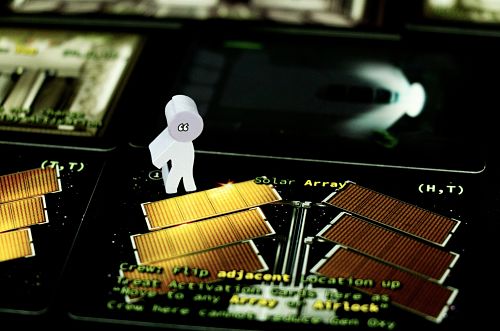
The art on the cards is pretty basic, which I’m totally fine with. It gets the feeling across just as well as any other type of art could. The ship cards give you a good look at what the ship looks like inside, but it’s not sprawling with detail (again, I’m totally fine with this). The box art is great though, but all in all, the art is simply perfect for what the game is.
However, the components may be a bit lacking. Not everything, mind you—the cards are fine and I love the dials—but the player pieces are a bit on the lacking side. Mostly, I guess, it’s the stickers placed on the character meeple pawn things to differentiate them from the others. The symbols on the stickers are your generic keyboard symbols (<, >, ^, etc.), which works, but it tends to throw me out of the game. Honestly, now that I write it, it sounds really petty to say. It really is such a small detail, and yet, for some reason, it feels…odd to me. That said, it will never keep me from playing.
The rule book might, though. It wasn’t as clear as I had hoped, and while I am pretty good at putting things together when rules come across as confusing, there were a number of places I kind of had to “pretend” I understood and play with whatever level of understanding I had. But, despite being a small-ish barrier to entry, the gameplay is still wonderful. You just have to get through the rules first (or find a video). And, uh, sometimes the card text can be a bit confusing too, but it’s not too difficult to piece together once you get going.
Standout Performances
- Strong theme
- Deep immersion
- Expansions that vary the challenges and add new content to the game
- Wonderful at 1-player count
- Semi-cooperative gameplay keeps the tension up
Breaking the 4th Wall
In theater, breaking the fourth wall refers to when characters (or something else) directly address the audience, thus pulling them out of the narrative and making the astutely aware that they are, in fact, watching a performance and that’s it’s not actually real.
I think I’ve already mentioned the few negatives of SSO, those being the rule book, card text, and a few component things. All in all, these negatives are insignificant compared to what the game has to offer. So take that for what it’s worth.
Gameplay Review
SSO First Impressions
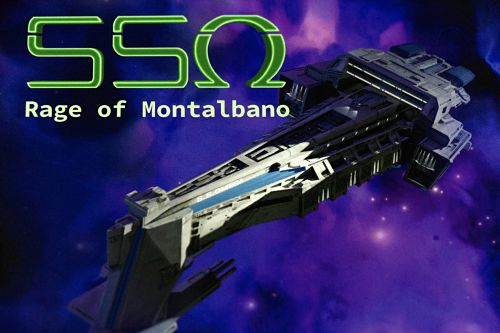
The game box looks so great! Like, I was ready to dive into to this beautiful world of horror and doom when, in reality, the lackluster presentation caught me off guard. That’s not to say I don’t mind the look of it, but first impressions can do a lot for a game. Much like a good book with an…interesting cover, I opened up the game, played it, and really enjoyed it. Although my first impressions weren’t as good as I had hoped, the gameplay made up for it.
Setup
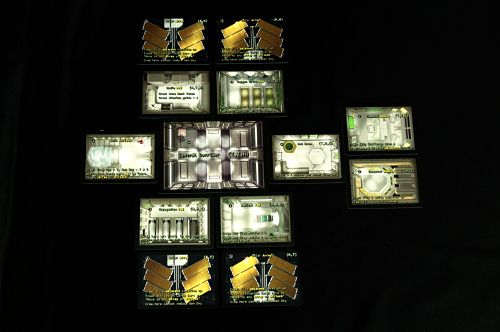
The setup is relatively straightforward, as you’re simply laying the ship’s cards out according to the rule book. This part is simple, and starting positions are just as easy. Honestly, setup isn’t huge at all, and can be quite quick, once you know what you’re doing.
My only concern with setup is the various cards. I had to be careful to organize the contents in such a way that I could easily unpack everything instead of sifting through the cards to find the type I needed. Again, not a big problem at all, and it’s something you can mitigate with some savvy organization.
SSO Gameplay
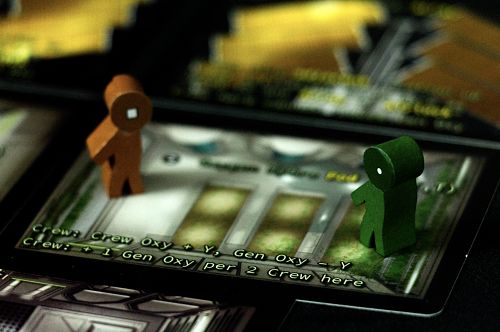
The gameplay is, of course, the most important part of any game. And SSO is fun. And the activation is quite neat.
During the activation phase, each player is dealt a number of activation cards equal to the number of characters they control, plus one. Each character they control is then given one of the cards, and this card will dictate (in a way) what that character can do on its turn. The activation cards have text on them giving specific instructions. These cards are invaluable if you need to do what the card says. But, sometimes, you don’t want to, and other times it would be downright debilitating if you did. Fortunately, you can spend the cards in other ways (i.e. discarding it and another not-yet-activated character card to move to that character’s location), or simply pass. But these activation cards present an interesting mechanism in that I found I was frequently changing my mind about what I wanted to do because of the activation cards I was dealt. There’s definitely some balancing you have to consider when divvying out the cards, and I really like that about SSO.
After the activation phase, then everything else happens. Auto-events trigger, such as gaining morale in the Rec Room. Characters die if they are in a room all by themselves and their morale is at zero. Oxygen is depleted based on how many characters are left alive. Characters can also take actions that correspond with the room they are in (vent oxygen, gain oxygen, repair a room, etc.). If a mission fails, you deal with the consequences. And, of course, a new challenge card is played.
The challenges are what makes SSO so intoxicatingly addicting and stressful, all at the same time. This is where something bad usually happens (unless you’re really lucky), and where you and the other crew members can vote on whether to accept a newly revealed challenge or not. Completing challenges is crucial to winning, but having too many challenges active at one time can make things even more difficult. It’s a fine balance, and even if you’re right, you’re still wrong if you’re outvoted.
And so the game continues, round after round, until all of the challenge cards are gone (you win!) or there are no more crew alive (you lose…). As with any good (semi)co-op, things get progressively more dire as the game progresses. And it’s that escalation that makes SSO such a good one.
Thoughts on Gameplay

Overall, I really enjoy playing SSO. I love the stress that comes with the new challenges, the kill-or-be-killed nature of some of the decisions, and slow escalation into madness and death (and, sometimes, victory). Is the game good? I certainly think so. I enjoy the depth of theme and immersion, and the choices are difficult—sometimes choosing between a rock and a hard place.
The game is well designed and provides enough of a challenge for many, many play-throughs even without any expansions. Yes, it took more time than I would have preferred to learn it and get through my first game, but once I learned it, I really enjoyed coming back to it time and time again. Sometimes you have to look past a book’s odd dust cover to reveal the gem of a story beneath. So it is with games; get past some initial barriers, and you have a gem that you’ll be happy to have for years down the road.
Solo Play

Playing SSO solo is easy—you simply control everybody! And voting on missions doesn’t require guessing how your fellow crew members are going to vote. I’ll be honest—I think I prefer SSO as a solo game. And, to me, that’s almost a bigger win than being able to play with others (but it still plays well with others, so don’t worry). But that’s maybe because I get to make all of the decisions, and I’m not stuck relying on someone’s asinine scheme to survive at my expense. But, again, that’s part of the fun of playing with others, too, so you be the judge.
SSO Expansions
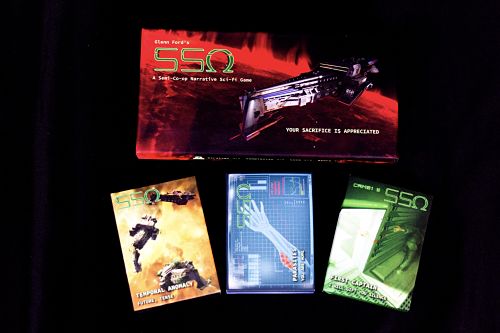
I mentioned that SSO has great replay value even with just the base game and no expansions. But, there are a number of expansions that add some great content to the game with fun new thematic twists and, well, sacrifices.
SSO Final Thoughts
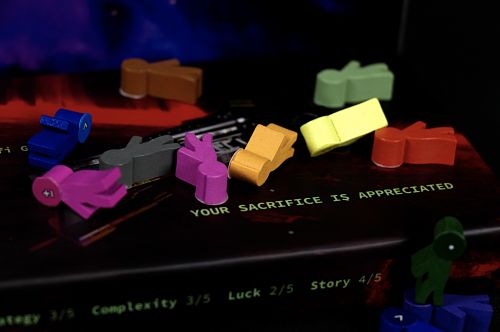
After fully immersing myself into SSO, I can honestly say that I’m a fan. It took some doing to get to that point (looking at you, rule book), but I’m glad I pushed through. When talking about the gameplay, it’s a joy. Even when everything is falling apart around you. There is a lot of content just in the base game from the host of characters, and the challenge deck is always making a mess of things (in a good way).
Final Verdict
If you’ve read the entire review, then you know I’m a fan of the game, but you’ll also know that it was something of a struggle to get to that point. So, with all things considered (the good, the bad, and the AI trying to kill me), I’m giving SSO a final verdict of TwoLaodiceanThumbs. I really wanted to avoid the Laodicean bit, but the rules struggle and the sometimes confusing card text did bring it down a notch. Not to say that the game’s not good, but that there is an unintended barrier before you get to that point.
Like This, Like That
I haven’t played a lot of horror games, and survival games have been few and far between as well. However, I think that if you like games like Nemesis, SSO has a lot to offer in a much (much) smaller and table-friendly manner. Sure, there are no miniatures or hulking aliens, but the constant duress of not knowing what on earth is going to happen is closely related to Nemesis. Don’t get me wrong, they are two completely different games, but the feeling can be similar.
Also, if you like stabbing your friends in the back, then you can get a kick out of this one. But if you’d rather not stab anyone in the back, you can go that route, too.
Verdict Scale (Lowest to Highest)
The Final Verdict is based on a scale of 1-7, although this scale is not numbered. Instead, it uses thematically appropriate words to describe the performance of the game.
Tomatoes – This game was emotionally taxing and difficult to finish.
Uninspiring – This game had me daydreaming about other games.
Lackluster – This game had its moments, but it probably won’t see much table time.
Laodicean – This game is decent. It works. There’s a reason people like it.
Two Thumbs Up – This game is pretty dang good.
Captivating – This game is outstanding! It’s more than good; it’s practically a staple.
Standing Ovation – This is the best game you will ever play. Period.
Read short fiction inspired by board games at BGI’s stories page!
Visit Man o’ Kent Games on Facebook, Instagram, Twitter, and their website.

